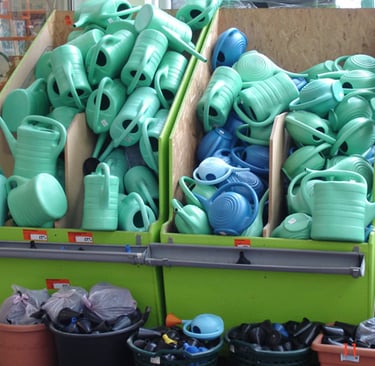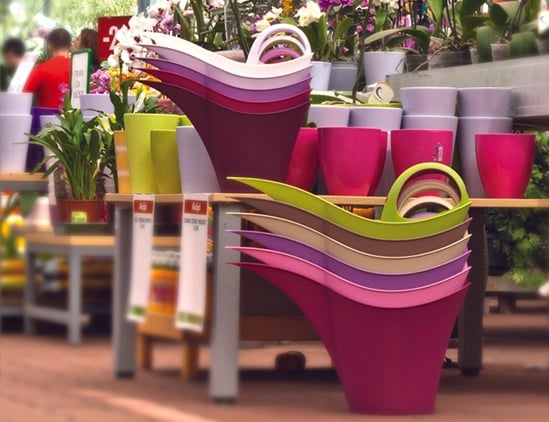WATERING CAN REVOLUTION
Igor Juric - Keira Designer
7/3/20253 min temps de lecture


Watering Can Revolution
How I Invented KEIRA, And Why It’s Redesigning Sustainability One Pallet at a Time
It began, as many revolutions do, not with a bang, but with a stare.
I stood motionless in a sprawling garden center, surrounded by the usual riot of plants, pots, and discount banners screaming for attention. But what caught my eye wasn’t discounted, it was just disgracefully displayed.
Dozens of plastic watering cans were hurled into two oversized bins like rejected props from a low-budget children’s show. They slumped and tangled into one another like a failed art installation titled “How Not to Ship Anything”. Handles collided. Spouts stuck out like antennae searching for logic. Air glorious, empty air, filled the gaps.
No one tried to stack them. No one even tried to pretend this was okay.
It wasn’t a display. It was a symptom.
A visual diagnosis of design apathy.
“That’s how they were delivered,” said a young employee with a shrug, catching my bewildered look.
I pointed. “You’re transporting more air than product. These cans are like rigid balloons.”
He blinked. I turned and walked away, but my mind didn’t.
Seeing the Obvious, Finally
I’m a product designer. And I had just witnessed a failure so common, so accepted, that no one thought to fix it.
Watering cans, by design, are awkward. Most don’t stack. Their handles and spouts collide. Which means they take up vast volumes during transport, costing more in logistics, fuel, and emissions than anyone wants to admit.
That evening, back home, I couldn’t let it go. I paced. Sketched. Prototyped. I thought about stackable glasses. Nested bowls. IKEA hacks. Geometry, gravity, ergonomics. And somewhere between logic and obsession, I drew two interlocking "V" shapes.
The next day, I modeled it in 3D. The design was ugly. But it worked.
A Design Born From Refusal
I refused to accept that form and function couldn’t meet in a watering can. That top handles and stacking were mutually exclusive. That elegance had no place in utility.
I studied nature — palm leaves, petals, bird beaks. I traced silhouettes and reverse-engineered aesthetics. Slowly, the KEIRA watering can began to emerge.
Not just stackable. But beautiful.
Not just compact. But ergonomic.
And then I ran the numbers.
Up to 700% volume savings.
Let that sink in.
That’s seven times fewer trucks on the road. Seven times less CO₂. Seven times more reason to rethink every mundane product we take for granted.
From Idea to Industry Disruption
Of course, no one thought it could be made.
Too complicated, they said.
Too ambitious.
Too "different."
But here’s the truth:
Good design isn’t always easy. But bad design? That costs us far more in the long run.
So I found engineers. Mold makers. Plastics experts. I rebuilt the tooling. I optimized wall thickness, nesting depth, and water volume. KEIRA was no longer just a sketch — it was ready.
The Bigger Idea
KEIRA is a watering can. Yes.
But it’s also a lesson.
That the world doesn’t need more things. It needs better things.
That sustainability starts not with slogans, but with geometry.
That innovation doesn’t mean inventing something new — it means questioning what already exists.
I didn’t invent the watering can. But I refused to ignore its waste.
KEIRA is proof that design can be humble and revolutionary at the same time. That one small product, reimagined, can ripple across supply chains, cut emissions, and inspire better thinking.
Sometimes, all it takes is a watering can — and the refusal to accept what doesn’t make sense.
Want to join the KEIRA revolution?
Visit our gallery. Talk to us. Rethink the ordinary.


Get in touch
KEIRA d.o.o.
Kanalski put 1
10000 Zagreb, Croatia
Email: info@keira-garden.com
Phone: +38518887999
WhatsApp: +385989011672
© 2025. All rights reserved.
